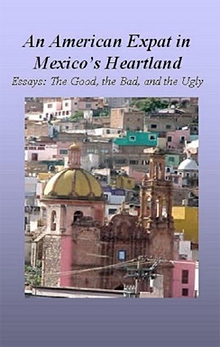 |
 |
 |
 Editorials | Issues | January 2007 Editorials | Issues | January 2007  
Guanajuato: The Death of Heritage
 Doug Bower - PVNN Doug Bower - PVNN


| An American Expat in Mexico's Heartland - click HERE for info

I hope what I write in this book will make you think twice about moving to México. I am not saying that in any sort of selfish sense as if I want to keep México all to myself. Not at all. What I mean is that México does not need more Americans who try to conform it into their American image. That is what happens in expat enclaves and American sectors and it is why I write what I do and how I do. México has had enough Americanizing Colonization with its horrible results seen in San Miguel de Allende.
- Doug Bower |
Gentrification is “the process of renewal and rebuilding accompanying the influx of middle-class or affluent people into deteriorating areas that often displaces earlier, usually poorer, residents” (Webster’s).

Gentrification is occurring in Guanajuato.

When we decided to move to Guanajuato instead of to one of the many cities in Mexico, it was because it was, at that time, “still Mexico.” Gringos live everywhere in this marvelous country. The largest populations are in Mexico City as well as in the resort areas of the West Coast. It is estimated that around 25,000 gringos live in Puerto Vallarta.

San Miguel de Allende, in the state of Guanajuato in Mexico’s heartland, has about 12,000 Gringos — most of whom come from the USA.

We didn’t want to live in any of the areas where Americanization has taken over to extent that they are barely recognizable as Mexico. San Miguel de Allende is a perfect example of how the influence of such a large, and might I add, excessively demanding American enclave has changed the town from colonial Mexico to Gentrified Mexico. Americanization is its defining theme. San Miguel de Allende “looks” Mexican. It is, however, Mexican in facade only.

We wanted to live where that wasn’t happening or where it hadn’t yet happened. We chose the city of Guanajuato.

Did we err?

Late in 2006, the first signs of Gentrification in colonial Guanajuato began. A Mexican version of a “Super Wal-Mart” opened. We now have a Mega superstore. It is an anchor store in an indoor mall that contains what you would expect to see in any mall in the USA. There is a Blockbuster video store, General Nutrition, and various other stores that no average Guanajuatense (someone who lives in Guanajuato) could possibly afford. There is even an exclusive men’s store with clothing imported from Italy. And, to top it all off, there is cholesterol-laden, heart tissue-destroying, obesity-inducing MacDonald’s selling seven-dollar hamburgers. They’ve also throw in a multiplex movie theater for good measure.

Just as in America where the arrival of these superstores has all but ruined small downtown America, these stores in Mexico are causing the same problem. Whether it is a Wal-Mart (and Mexico has plenty of them), or the Mexican version, Mega, they have come into towns without a thought about how they will effectively alter the lives of hundreds, if not thousands. What happens is a way of life, one that works, one that enriches, one that promotes community and the fellowship of its members, is destroyed.

Heritage is lost forever.

What has happened all over America is happening here. In America, Wal-Mart has become the new “downtown.” In the days of yesteryear when I was a kid, it was a custom to go downtown. We would walk the sidewalks, stare at the window displays, and end up where everyone did—the drugstore. There we sat, drank sodas and ate ice cream while our parents caught up on the neighborhood gossip. It was there where relationships were forged and strengthened. It was there where those in trouble found comfort and solace. It was there where you would find reassurance that, though the world seemed to be falling apart, you could survive with the help of your friends. It was true community.

Now in America, no one drives to downtown if one even exists. No one walks anywhere. Wal-Mart and all its derivatives are the new downtown. Instead of going downtown to shop, everyone heads to where the products are offered at prices the old local Mom-and-Pop shops cannot possibly beat. Instead of catching up on the gossip, instead of forging relationships, instead of finding comfort, solace, and strength to get you through a crisis, instead of community, you find a cold and impersonal factory where you recognize no one. You find a sea of people rushing in and out of a warehouse filled with goods. No one talks. The employees barely acknowledge the customers. Everyone rushes through the store trying to get their stuff as fast as they can so they can leave and get back to what has become a miserable urban existence.

Too harsh? I don’t think so.

Just think of this.

When was the last time you waltzed into Wal-Mart to buy a pair of socks, a transaction taking mere minutes, but left refreshed and more energized than when you went in? When was the last time you spent an hour, maybe two, in Wal-Mart (and all you came to buy were socks) because you saw someone you knew and took the time to talk and minister to one another’s needs?

When was the last time you went to a Wal-Mart superstore because you knew you might meet “so-and-so” and get to see what’s happening in her life and share what’s happening in your life?

That’s what we saw in Guanajuato: a life we remembered, loved, cherished, and missed from our childhoods in the 50’s and early 60’s. | 
 | |
 |



